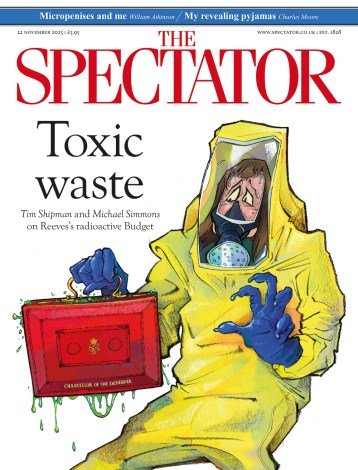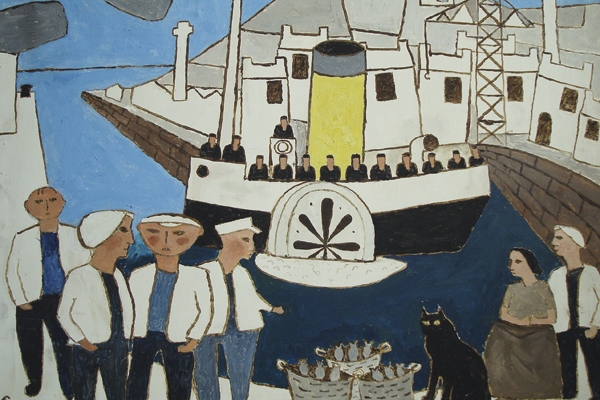Between 1917 and 1923, Julian Trevelyan produced a map and an illustrated guide to Hurtenham, an industrial town on the Tees between Stockton and Darlington. You’ll search in vain for the place in an atlas today, as the entire town, with its warren of streets, railways, parks, public buildings and monuments to local luminaries, was the figment of a pre-teen imagination. But the wit and ingenuity of its conception — and its bird’s-eye views of an abstracted world — set the creative pattern for what was to follow.
Born into a family of writers and intellectuals, Trevelyan was not destined for an artistic career. When he dropped out of an English degree at Cambridge in 1931 to study art in Paris, his uncle G.M. Trevelyan expressed the hope that he was not ‘going to meet one of those Matisses or Picassos’ — which of course was just what his nephew had in mind. But during his four years of haphazard self-education in a Montparnasse studio adjoining Alexander Calder’s, the artist who had the most lasting influence on him was in fact an Englishman. It was while assisting the experimental printmaker Stanley William Hayter in his legendary Atelier 17 that Trevelyan rubbed shoulders with Masson, Ernst, Miró — and occasionally Picasso — and that, along with hands-on experience of developments at the cutting-edge of etching, Surrealism rubbed off on Trevelyan.
To mark the launch of Julian Trevelyan: Picture Language, a new book on the artist by his son Philip (published by Lund Humphries), the Bohun Gallery in Henley has put together an exhibition of some 30 works from all periods of his career, starting with a Picassoesque ‘Figure (after Piero della Francesca)’ painted in Paris in 1933 that would have confirmed his uncle’s worst fears. In the same opening room a fragile Klee-like construction of tensile lines describing a ‘City’ (1936), annotated with surreal pictograms of kites, boats, comets and keyholes, sits alongside a ‘Mediterranean Landscape’ — a juxtaposition illustrating the youthful personality clash between the representational images Trevelyan called his ‘Jekylls’ (which sold) and the Surrealist ‘Hydes’ (which didn’t). A collaged ‘Landscape with Church and Telegraph Pole’ (1937) dates from an eccentric episode in his early career as a volunteer for the anthropologist Tom Harrisson’s ‘Mass Observation’ project, a scheme involving posting middle-class observers to places like Bolton and Blackpool to record the ordinary British way of life. Never one to duck a challenge, Trevelyan chose collage as his medium of record, working out of a suitcase on the pavement with scissors, gum and Indian ink. To local observers with a small ‘o’, he must have seemed quite mad.
As a self-taught artist, Trevelyan passionately believed that art should be part of everyday life; he admired Alfred Wallis and visited the Pitmen Painters in their tin hut studio at Ashington Colliery. On the eve of war he resigned from the Surrealist Group, feeling that the movement had outlived its usefulness: ‘It became absurd to compose Surrealist confections,’ he later wrote, ‘when high explosives could do it so much better, and when German soldiers with Tommy guns descended from the clouds in parachutes dressed as nuns.’ His Jekylls and Hydes resolved their differences and eventually merged into a distinctive personal style. True, paintings like ‘Paddle Steamer’ (1986) and ‘Harbour’ (1988) show the marked influence of the St Ives School — Trevelyan had been in Cornwall as a camouflage officer during the war. He was more himself on his home stretch of water, the Thames flowing past his Hammersmith studio at Durham Wharf with its ceaseless traffic of floating forms, nautical and natural, including the rather comical wartime ‘Swans’ (1943). But his unique contribution was in the field of print. Here his elementary grasp of composition, in the truest sense, reduced reality to its essential elements — a tendency to simplification that became more pronounced after an attack of meningitis in 1963 left him better able to control an etching needle than a brush.
Having had to quit his post as inspirational Head of Etching at the Royal College of Art — where his students included David Hockney — Trevelyan went on his travels with his second wife Mary Fedden, each new journey sparking a new suite of prints. A procession of windmills on the coast of Crete inspired the first etchings made after his illness, along with a painting in the exhibition. Machinery had always fascinated him, and despite the exotic charms of his ‘Hindu Temple’ (1968) with passing Brahman bull, his most memorable images are urban or industrial. ‘Avenue of the Americas’ (1982), with its stream of black and white cars funnelling faceless passengers down Sixth Avenue under a violet sky, is an iconic image of New York, while ‘Runway’ (1973) and ‘Jets’ (1974) sum up the lumbering preposterousness of air travel from the perspective of someone living under the Heathrow flight path.
It’s the ‘deliberate persistence in his own kind of sophisticated innocence’ described by Mel Gooding in his foreword to the book that makes Trevelyan’s work such a visual tonic. His last big retrospective was at the Royal College in 1998. Time for another.






Comments